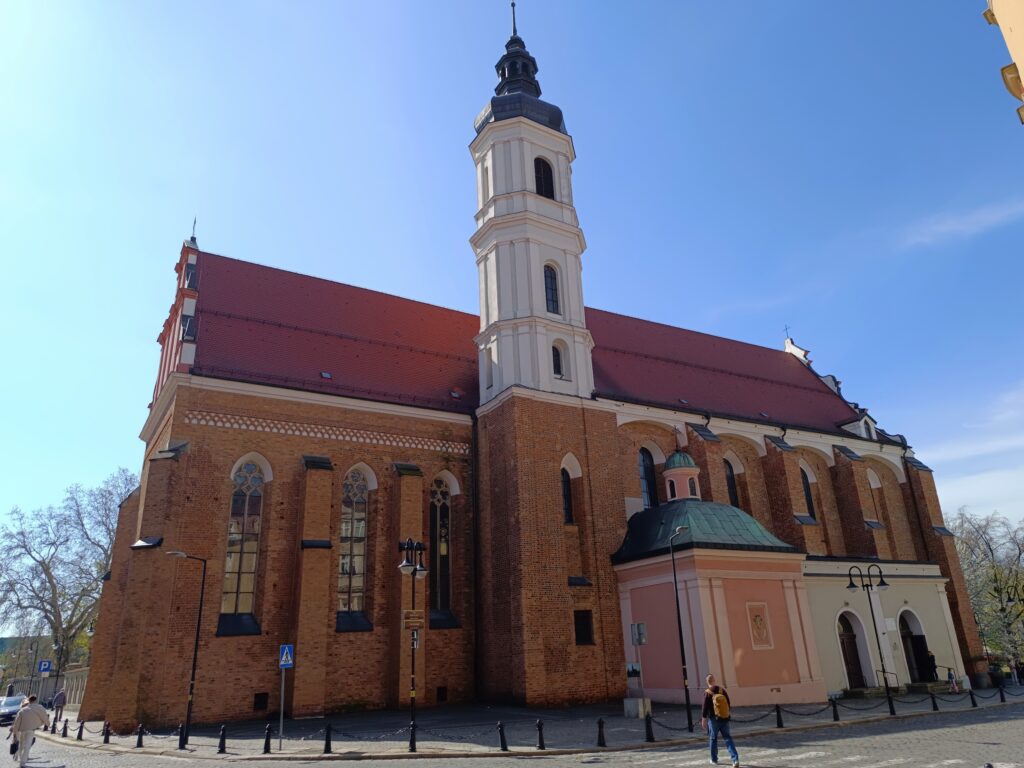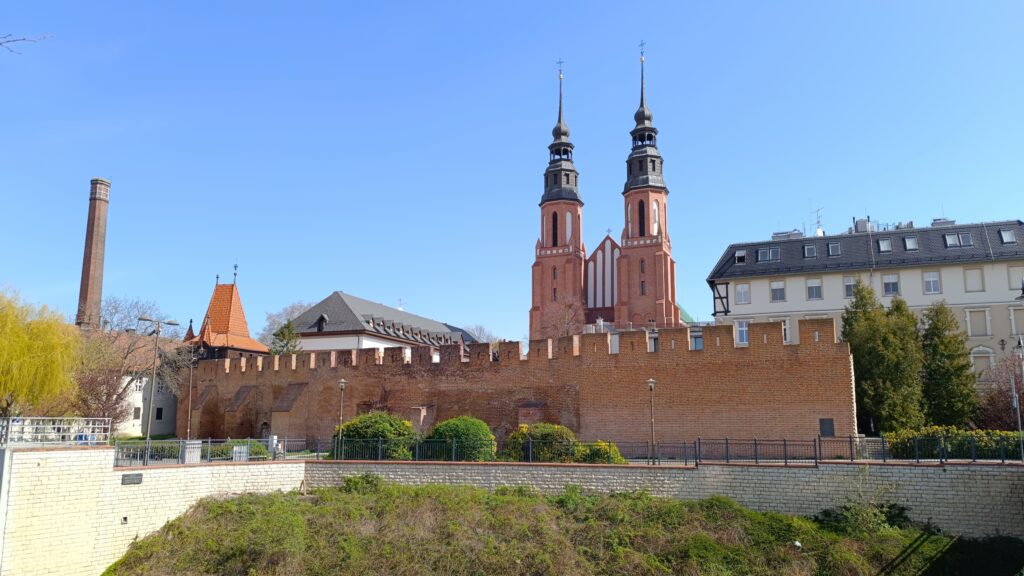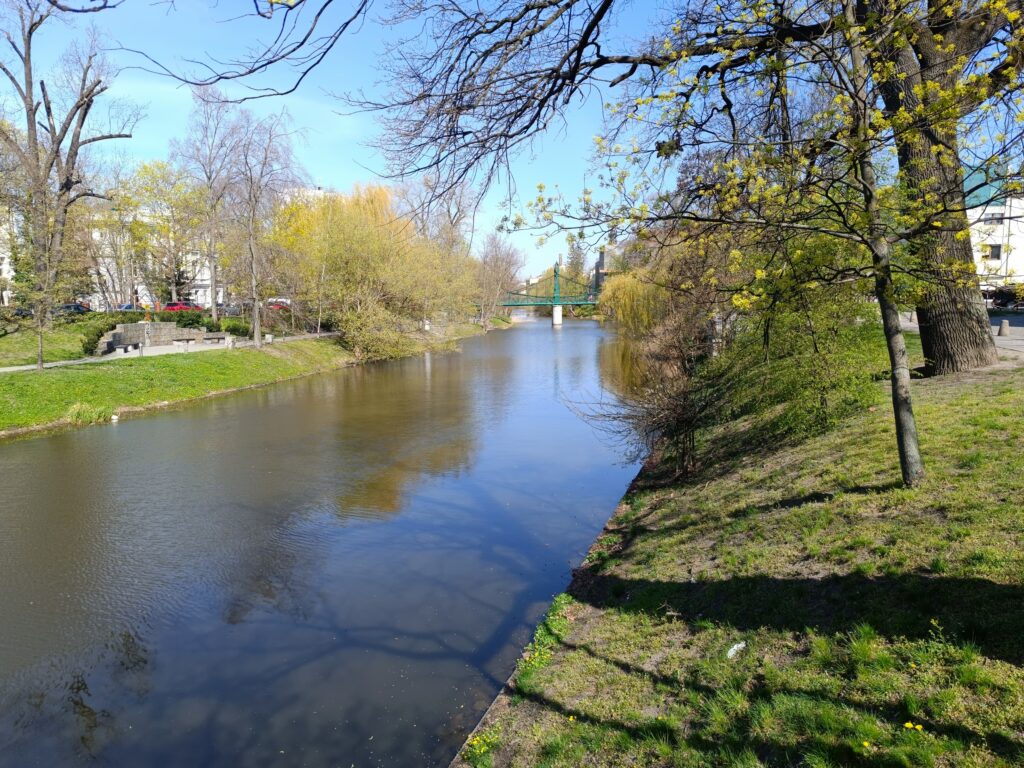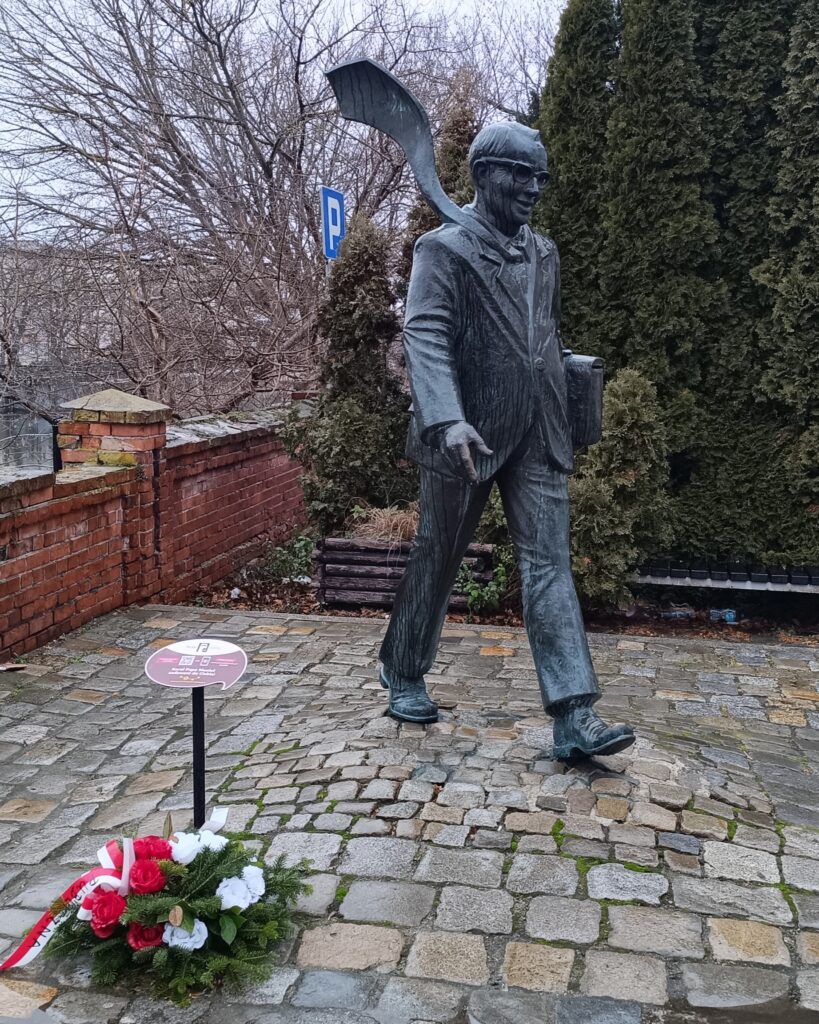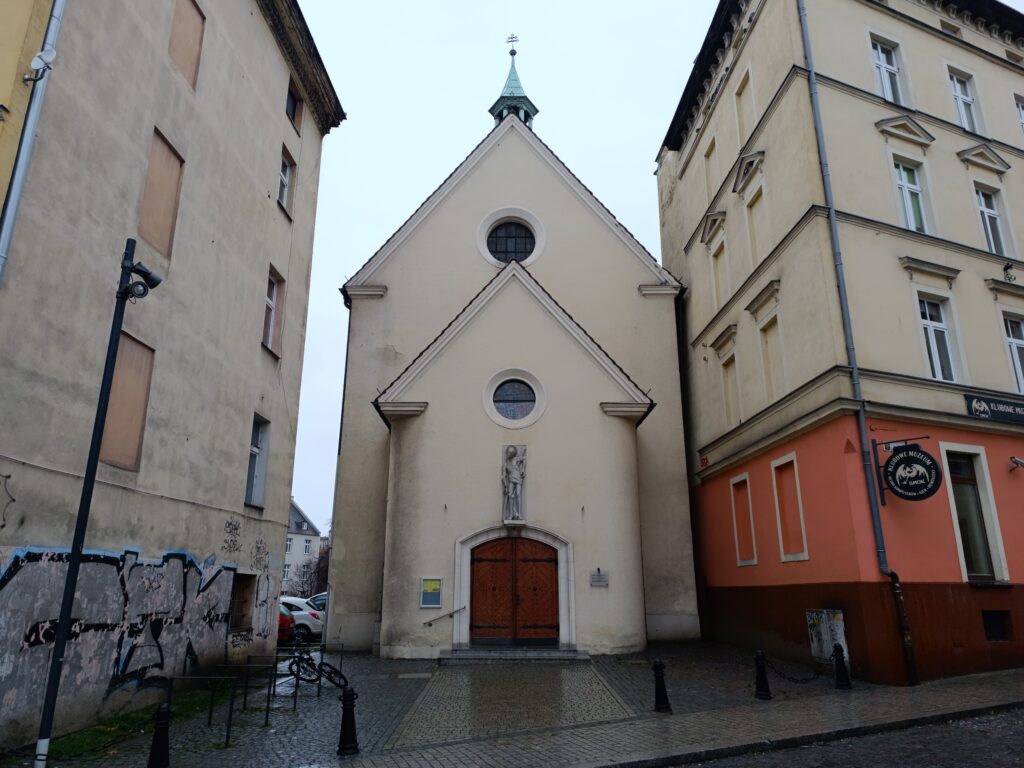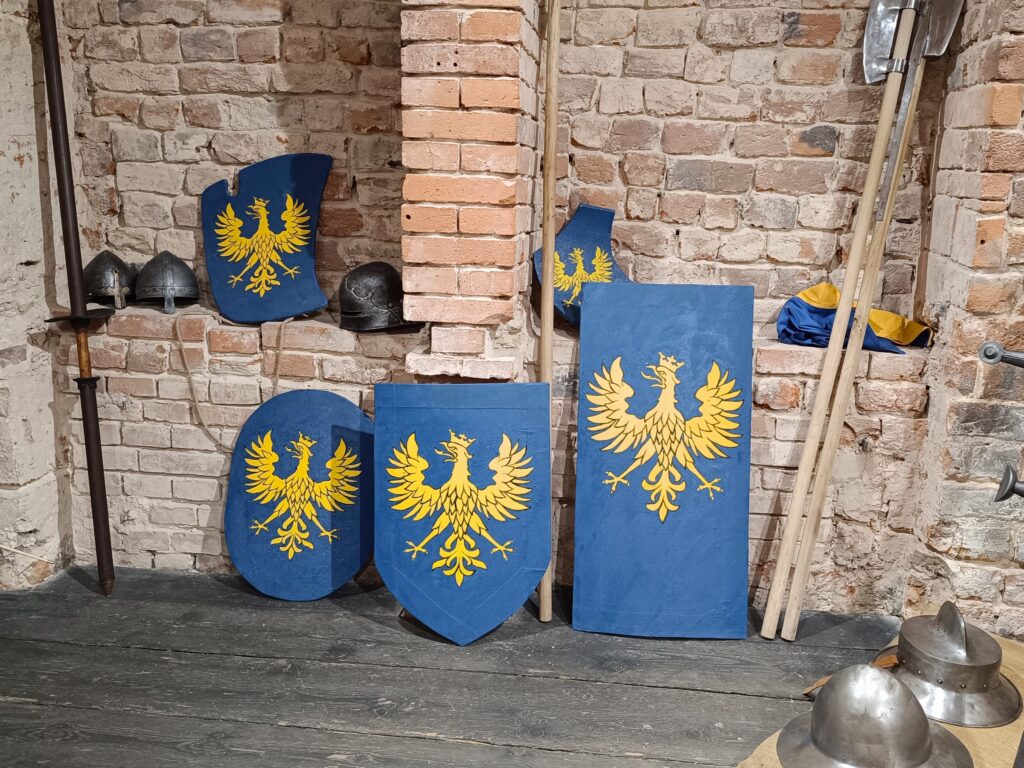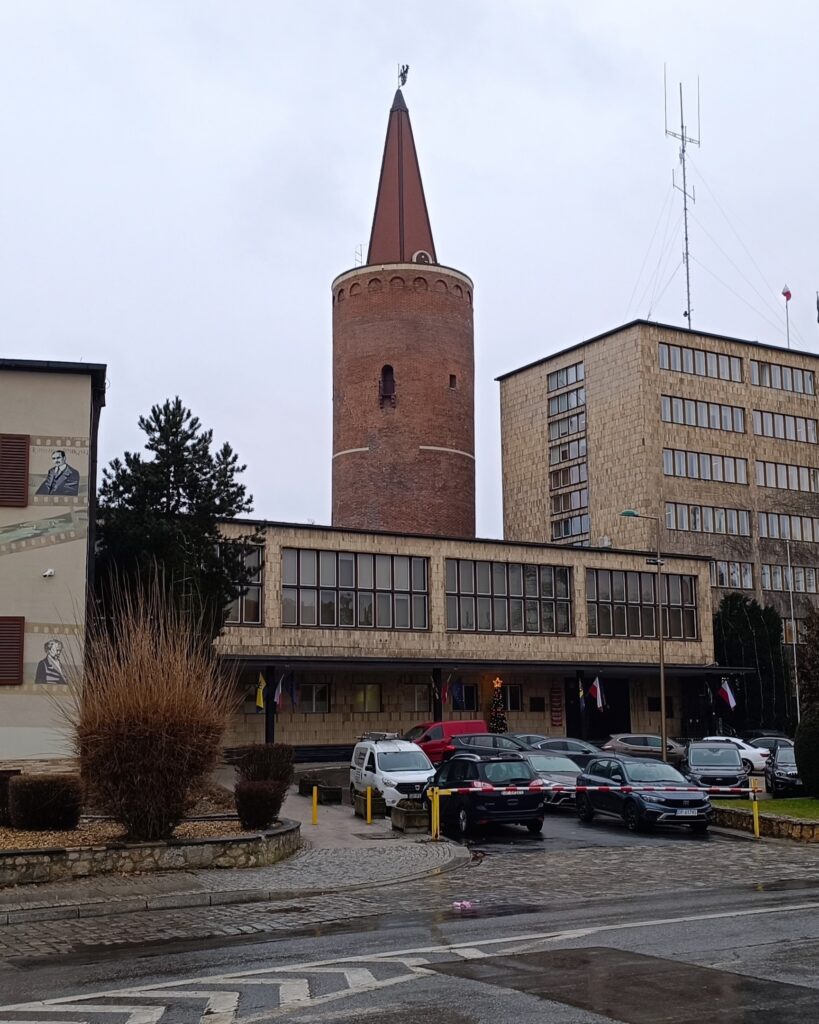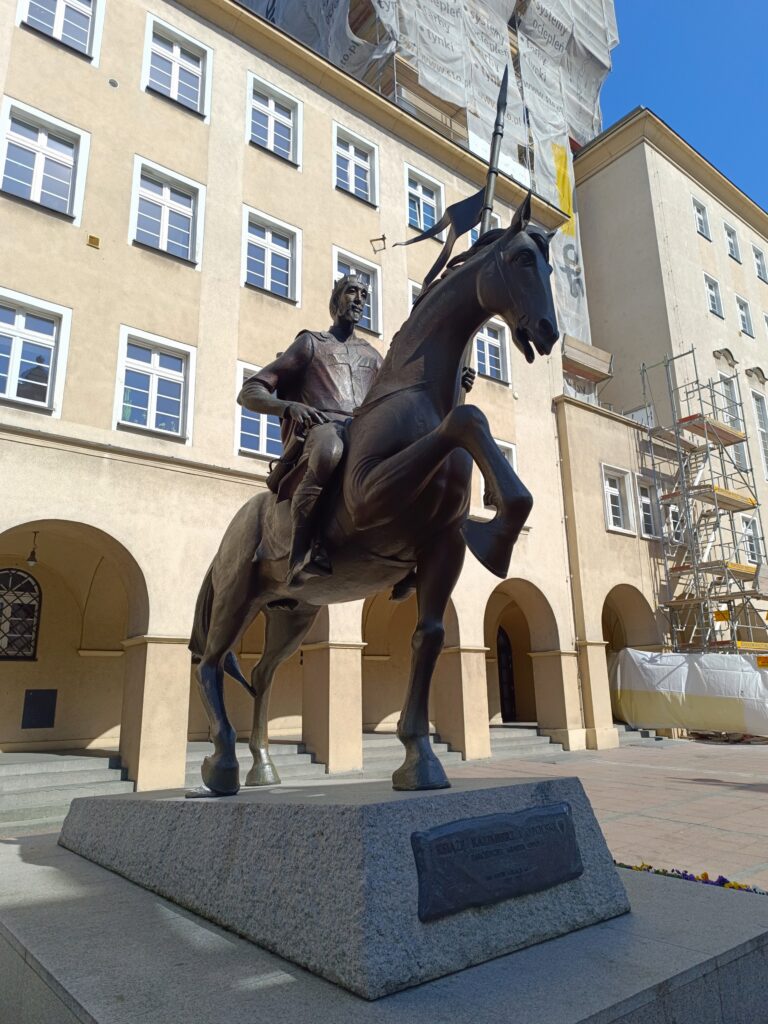All you need to know about the city of
Opole
Poland
Sightseeing
Beyond the symbolic Piast Tower and the Upper Castle, Opole is home to the sarcophagi of the Piasts of Opole, the charming Opole Venice, and even... the Polish Song Museum.
Curiosities
As the most important city in the region, Opole boasts unique traditions and legends. There’s a tale of a cursed princess, the city has its very own dinosaur, and—believe it or not—it’s also where the first Polish eagle is said to have appeared.
History
Opole is one of the two capitals of Upper Silesia. Even though the Duchy of Opole spent much of its history outside of Polish rule, it had a significant impact on the region. The dukes of Opole repeatedly tried to seize power in Kraków or divide Poland alongside other neighboring powers.
CONTENTS
SIGHTSEEING
Piast Tower
Admission: 18 PLN regular, 12 PLN reduced
The Piast Tower is the only remaining part of the former Piast Castle in Opole. The castle itself dated back to the 13th century, while the tower was added during an expansion in the 14th century. For centuries, it served as the main seat of the rulers of Opole. The castle was eventually demolished between 1928 and 1931, and only protests by the Polish minority saved the Piast Tower from the same fate.
Today, the Piast Tower is not only a local attraction but also an important symbol of the city. It can be visited with a guide every hour on the hour, and the entire tour lasts about 40 minutes. In addition to enjoying a panoramic view of Opole, visitors can hear stories about the tower’s history and watch special animations shown during the tour.
Upper Castle in Opole
Admission: 12 PLN regular, 8 PLN reduced
The Piast Castle wasn’t the only castle that once stood in Opole. The city was also home to another fortress, known as the Upper Castle, which was erected at the end of the 14th century. It was built as a sign of the wealth of the ruling duke at the time, Władysław of Opole. Unfortunately, his successors didn’t quite know what to do with a second castle. This led to its gradual decay, and after a fire in the 17th century, it was eventually dismantled. Only a square tower survived, which was used as a granary at the time.
Over the following centuries, various buildings were erected around the tower, including a church, a secondary school, an art gallery, and a second school wing. It was only recently that the true age of the tower was recognized. Archaeological work was carried out there in the late 2000s, and in 2018, the tower was opened to the public.
Guided tours are available and last about 40 minutes. During the visit, you can learn about the history of the tower and the purpose of its individual chambers. The site also features replicas of historical weapons and armor, which visitors can try on to get a sense of their actual weight.
Museum of the Opole Silesia Region
Admission: 15 PLN regular, 10 PLN reduced
The Museum of the Opole Silesia Region is explored individually, without a guide. Visiting all of the exhibition rooms should take about two hours. The museum features a local ceramics exhibition, an art gallery, archaeological collections, as well as historical and ethnographic displays. Additionally, there is a collection of 20th-century photographs on show.
It’s worth noting that admission is free on Thursdays.
Opole’s Venice
Admission: Free
Opole’s Venice is a charming spot located along the Młynówka Canal, which separates Pasieka Island from the mainland. A walking path and cycling trails have been created here, complemented by numerous viewing terraces and benches. The proximity to the water and the picturesque setting evoke the feel of the Italian Venice — the inspiration behind the attraction’s name.
Daszyński Square with the Opole Ceres
Admission: Free
The fountain at Daszyński Square was built at the beginning of the 20th century. At its top stands a sculpture of the Roman goddess of harvest — Ceres. Below her are several other figures with symbolic meaning. Neptune and Glaucus represent Opole’s river navigation and goods transport along the Oder River. Hercules, holding a pickaxe, symbolizes industrial development. Meanwhile, Ceres and Proserpina, holding sheaves of grain, refer to agriculture as a key part of the region’s economy.
Church of the Holy Trinity
Admission: Free
The Church of the Holy Trinity is closely tied to the arrival of the Franciscans in Opole. In the 13th century, they built their monastery here along with the church itself. This place witnessed numerous historic events—in the 17th century, calls to mobilize against the Swedes were made from its pulpit. During Prussian rule, the church was converted into a Lutheran one, but after the war it returned to its original form. To this day, the Franciscan monastery remains active next to the church.
The Church of the Holy Trinity is also one of the burial sites of the Piast dynasty of Opole. Their remains can still be seen today, placed in two sarcophagi. Unfortunately, the sarcophagi are not labeled—during the Millennium Flood in 1997, water flooded the church, causing the bones to become mixed. The church itself impresses with its interior, featuring numerous reliefs and a magnificent altar.
Interestingly, the Chapel of Saint Anne was built here in 1309—it is the oldest chapel dedicated to Saint Anne in all of Silesia.
Market Square
Admission: Free
The Market Square in Opole is one of the city’s central and most important places. At its heart stands a monumental neo-Renaissance town hall, whose architecture was inspired by the Italian city of Florence. Interestingly, every day at noon, the Opole bugle call is played from the tower. This melody, composed in 1952, is based on a local folk song.
The square also features a monument of Kazimierz I of Opole — founder of the first independent Duchy of Opole — serving as a reminder to both residents and visitors of the region’s unique and distinct history.
Fragments of the City Walls
Admission: Free
Partially reconstructed fragments of Opole’s medieval city walls can be found near the Church of the Holy Cross. Their origins date back to the 13th century, when the walls encircled an area of 16 hectares. With a thickness of 2.3 meters and a height of 6.6 meters, the walls provided solid protection against invading armies. The structure was reinforced by 14 towers and a barbican.
In the 19th century, the walls were dismantled to allow the city to expand. However, in 2009, the best-preserved section was restored and now serves as a historical attraction for visitors.
Church of Our Lady of Sorrows and St. Adalbert
Admission: Free
The Church of Our Lady of Sorrows and St. Adalbert is the oldest church in the city. According to legend, it was founded in the 10th century on the very spot where St. Adalbert (Wojciech) once fervently prayed. Today, it’s affectionately known as the church on the hill due to its location atop a nearby rise.
Cathedral of the Holy Cross
Admission: Closed
As of April 2025, the Cathedral of the Holy Cross remains closed to the public. The reason is ongoing archaeological work, initiated after previously unknown structures were discovered during a floor replacement. The closure unfortunately prevents visitors from seeing some of Opole’s most important historical treasures, such as the tomb of the Opole Piasts. Nevertheless, the cathedral is worth seeing from the outside. Built in the Gothic style, it is especially recognizable thanks to its Neo-Gothic towers, which rise to a height of 73 meters, making it one of Opole’s most iconic landmarks.
Polish Song Museum
Admission: reduced 23 PLN, regular 30 PLN
Opole is also an important destination for music enthusiasts. Every year, it hosts the National Festival of Polish Song, which was established in 1963 and has become one of the most significant music events in Poland. It is for this very reason that a museum dedicated to Polish music was established in Opole.
This modern museum offers thousands of exhibits related to the history of the Polish music scene. Visitors explore the exhibition using an audio guide, which allows them to discover the displays at their own pace. The museum is sure to captivate children as well, thanks to many interactive attractions such as an electric drum kit and virtual mirrors that let visitors see themselves in various historical costumes.
CURIOSITIES
The First Polish Eagle Was Golden
The white eagle on a red background with a crown is the coat of arms of Poland and one of the most important national symbols. Traditionally, this image has been associated with the first ruling Piast dynasty. But when was it used for the first time?
Some believed it could be seen on coins minted during the reign of Bolesław the Brave. However, after analysis it is difficult to clearly determine whether it does not represent a different bird.. Therefore, the first documented use of the eagle in Poland is attributed to the symbol of Casimir I, Duke of Opole and Racibórz. This symbol appeared on the duke’s royal seal, which dates back to the year 1222. The main difference was that the eagle was golden, and the background was blue. Today’s coat of arms of Opole still refers to that tradition.
The Dinosaur of Opole
It turns out that Opole has its own… dinosaur? Silesaurus opolensis is a dinosaur named in honor of Opole. This 2.5-meter-long reptile can be found only in Poland, specifically in the regions of Opole, Silesia, and Świętokrzyskie. It was discovered in Krasiejów, located in the Opole Voivodeship. The remains of Silesaurus are kept in a museum in Warsaw, while a full reconstruction of the dinosaur has been created in Krasiejów, where it now serves as a tourist attraction.
The Ghost and the Ring
As a duchy, Opole developed rapidly, uniting the lands of Upper Silesia. However, all of this came to an end with the childless death of John II the Good. Why did he never marry? Legend offers an explanation.
It is said that the duke fell in love with the beautiful Princess Ofka and asked for her hand in marriage. At first, she accepted his proposal, and the wedding was planned for Midsummer Night. But just before the ceremony, Ofka suddenly broke off the engagement. As a symbolic act of rejecting his love, she threw the ring from the Piast Tower. John flew into a rage. He ordered her imprisoned in the castle dungeons and never looked at another woman again. His bloodline ended with his death.
It is said that every year, on Midsummer Night, the ghost of Princess Ofka circles the tower, desperately searching for the long-lost ring.
Left to the Plague
One of the tragic episodes in Opole’s history was the outbreak of the plague on March 31, 1679. It all began in a local inn, where a traveler infected with the disease died. The plague spread rapidly, claiming many lives and paralyzing the life of the city.
Faced with the threat, neighboring towns took drastic measures to protect themselves from the epidemic — part of the bridge over the Oder River was dismantled, completely isolating Opole. Only after many months did the plague finally subside.
In gratitude for surviving the disaster, the townspeople decided to build a church on the site of the former inn. They chose Saint Sebastian as its patron — a figure traditionally regarded in Christianity as a protector against infectious diseases. The church was completed in 1711 and remains an important sacred landmark in Opole to this day.
The Capital of Polish Song
The modern history of Opole is inextricably linked to music. In 1963, the National Festival of Polish Song was established to revitalize the Polish music scene and provide a platform for emerging artists. Its creation was a response to the conservatism of Polish Radio at the time, which limited young creators’ access to a wider audience. A key figure in choosing Opole as the host city for the festival was Karol Musiał, chairman of the City National Council, whose dedication was decisive in bringing the event to life there.
Thanks to the festival, Opole gained nationwide recognition and became a symbol of Polish popular music. Karol Musiał was honored with the title of “Opolanin of the 800th Anniversary,” and his statue, erected in 2008, can be found near the city center. In his honor, the Society of Friends of Opole — an organization that supports the development of local culture — is also sometimes referred to as the “Musiołówka.”
Our Father... and Up We Go
A hundred years ago, the first elevators were already being built. Of course, modern technology was unknown back then — paternoster lifts were popular instead. A paternoster is a continuously moving elevator that travels at a slow speed. That’s why it’s important not to miss your floor — the lift doesn’t stop! The name comes from the prayer bead chain, and paternoster is Latin for “Our Father.”
Today, very few of these lifts remain. In some countries, they have been completely banned due to safety concerns and their inaccessibility for people with disabilities. However, in Poland, five paternoster lifts are still in operation — and two of them are located in Opole. One can be found in the building of the Provincial Police Headquarters, and the other in the Voivodeship Office — and yes, you can still take a ride in it!
The Missing Explosion
Let’s travel back for a moment to 20th-century Opole. It’s the year 1920, and the city is thriving. Industrial plants are operating at full capacity, supplying citizens with a wide variety of goods. One of these factories specializes in producing mineral fertilizers. However, the process generates an unwanted byproduct — ammonia. With no clear way to dispose of it, the substance was simply stored. Over time, due to improper storage, the ammonia solidified into hard, rock-like lumps.
Eventually, the decision was made to get rid of these deposits by selling them. But to do so, the compacted mass needed to be broken up. Sappers recommended using small amounts of black powder. The factory owners, however, opted for TNT instead.
This decision turned out to be disastrous. TNT, known for its powerful dispersive properties, triggered an explosion so massive that the entire factory ceased to exist. Fragments of ammonia were reportedly found up to 15 kilometers away. The tragedy was even allegedly commented on by Nobel Prize laureate Professor Fritz Haber, who mentioned as many as 600 victims.
Strangely enough, no material evidence of the explosion exists. The factory’s location has never been confirmed, and no physical traces of the incident have been found. So — did the explosion really happen, or is it merely a legend? To this day, it remains a mystery.
The Duke of Opole Who Reached for the Crown
When Duke Władysław of Opole came to power, Opole was a minor duchy under the rule of the Bohemian Crown. However, he aligned himself politically with the King of Hungary, Louis of Anjou. After the death of Casimir the Great, the Angevins took control of Poland, uniting the two realms. Władysław was appointed palatine — one of the highest-ranking officials in the kingdom — which greatly expanded his influence and wealth. The Hungarian king granted him large territories across what is now Lesser Poland, Silesia, and Łódź Voivodeship. He was also appointed governor of Red Ruthenia, where he notably contributed to the development of Lviv.
In 1378, Władysław was promoted to governor of the United Kingdom of Poland — the closest he ever came to the Polish crown. However, he didn’t hold the position for long. The nobility, dissatisfied with the growing influence of Hungary, blamed Władysław for the loss of Ruthenian lands. He was removed from his post, though compensated with new lands in northern Poland. He also expanded his reach in Silesia by acquiring surrounding duchies.
A noteworthy chapter in his life came in 1382, when Władysław clashed with the Church. As an act of atonement, he founded the Pauline monastery in Częstochowa — known today as Jasna Góra, Poland’s most revered sanctuary.
After King Louis of Anjou died, Władysław put himself forward as a candidate for the Polish throne. However, his proposal was quickly rejected, and Władysław II Jagiełło was chosen instead. In 1387, Władysław of Opole issued a manifesto calling for resistance against the newly elected king. The following year, he led a coup at Wawel Castle, which failed, resulting in his brief imprisonment.
Just a few years later, Władysław began cooperating with the Teutonic Knights, handing over his lands in northern Poland. This sparked another conflict with King Jagiełło in 1393, during which the duke lost even more fiefs. The final blow came in 1396, when Polish forces entered the Duchy of Opole and seized several towns. Peace was established on the condition that Władysław’s nephews would take over governance and ensure he would never again act against Poland. Władysław died a few years later, ending a turbulent and ambitious political career.
HISTORY
The Legend of Opole
Long, long ago, when the lands of Upper Silesia were covered in vast, impenetrable forests, there lived a ruler whose name has long since been forgotten. One day, he set off on a hunting expedition with his retinue. Unfortunately, during the hunt, he became separated from his companions and soon found himself completely alone. For hours he wandered through the forests along the Oder River, until at last — to his great relief — he stumbled upon a small village inhabited by peasants. Overcome with joy, he cried out, “Oh! A field!” (“O! Pole!” in Polish). In gratitude for his rescue, he decided to build a stronghold on the spot and named it Opole.
So Who Named Opole?
As charming as the legend may be, the true origin of the name Opole remains uncertain and likely more grounded in history than myth. One explanation suggests that the name derives from an old Slavic administrative unit. An “opole” referred to a cluster of settlements, fields, and pastures managed by a local chieftain. Another theory is based on a collegiate chronicle, which claims the town was named after a local knight named Apollonius. Over time, the name is said to have evolved from Opolonie to Opolie, eventually becoming Opole. Whether either of these theories is true remains a mystery likely lost to time.
Historically, Opole was established around the 9th century as a settlement of the Opolanie tribe. Even in those early days, the region was contested between Poland and Bohemia. According to historical accounts, the Czechs briefly occupied the territory before it was annexed by Mieszko I of Poland in 985. He is credited with constructing the first fortified settlement on Pasieka Island.
A few decades later, Opole was once again taken by the Czechs, but it was reclaimed 11 years later by Casimir the Restorer, who reinforced the settlement with defensive ramparts. Thanks to its strategic location on the Oder River, Opole became a key regional stronghold. The fortification of the town laid the foundation for its continued growth over the centuries.
The Eagle, Dukes, and Invasions
Opole remained under direct control of Poland until the country’s fragmentation, initiated by Bolesław III Wrymouth in 1138, when he divided the kingdom among his sons. This decision led to increasing feudal fragmentation, as regional dukes gained more autonomy. By 1172, Silesia had been divided into four parts, one of which was the Duchy of Opole. However, in 1201, it was taken over by Mieszko Tanglefoot, Duke of Racibórz, forming the first medieval Duchy of Opole and Racibórz — the largest state entity in the history of Upper Silesia.
In 1217, Opole was granted Magdeburg rights, allowing it to host regional assemblies and develop trade — effectively giving it city status. A few years later, construction began on the Piast castle. Around this time, the dukes of Racibórz-Opole began using a golden eagle in their coat of arms, making them the first Piast rulers to adopt this symbol. A Franciscan monastery was also established, where members of the Opole Piasts are still buried today.
Even the first Mongol invasion of Poland in 1241 did not halt the city’s development. In the Battle of Opole, Mongol forces achieved victory and burned down the city’s outer settlement, but the main part of Opole survived. After the invasion, the castle was expanded, further strengthening the city’s defenses.
Opole Against Poland
In 1290, the sons of the local duke divided the territory once again, forming a separate Duchy of Opole. This newly established state paid feudal homage to John of Luxembourg, the King of Bohemia. A renewed act of fealty in 1327 firmly brought Opole under the Czech sphere of influence.
During this period, the Dominicans established a monastery in Opole, which became a significant religious and cultural center for the region. In the mid-14th century, a Piast tower was added to the castle, and a wooden town hall was constructed — both important landmarks in the city’s infrastructure.
Nevertheless, the dukes of Opole did not abandon their ambitions within Polish territory. In the late 14th and 15th centuries, relations between Opole and Poland deteriorated considerably. The then-duke, Władysław Opolczyk, became a fierce opponent of King Władysław II Jagiełło and even attempted to depose him to seize the Polish crown for himself. He also allied with the Teutonic Order in efforts aimed directly against Poland.
Similarly, one of his successors, Bolko IV, collaborated with the Kingdom of Bohemia and the Teutonic Knights, signing an act of partitioning Poland in an attempt to expand his own influence. Later, Mikołaj I of Opole supported the Hungarians in their campaign against the Jagiellonian dynasty — further intensifying tensions between Opole and the Polish crown.
A Brief Rise Before the Fall
A pivotal moment in Opole’s history came in 1476, when Jan II the Good ascended to power. Under his rule, the Duchy of Opole expanded rapidly, annexing neighboring territories and even reuniting with Racibórz to restore the historic Duchy of Opole and Racibórz. Despite these notable achievements, the region began to decline just a few decades later.
The greatest issue facing Jan II was the lack of an heir. His only brother had been murdered, and although Jan lived to an old age, he never fathered a child. Rumors circulated that he was impotent. After his death, many noble families vied to inherit his lands.
The leading contenders were the Austrian Habsburgs, who already ruled nearby Bohemia — the senior state to which Opole was subordinate. However, after prolonged negotiations, the Hohenzollerns assumed control over Opole by leasing it from the Habsburgs — and paying handsomely for the privilege. Before handing it over, the Austrians managed to extract and export nearly all of the duchy’s valuables.
The Fall of Wealthy Opole
Jan II the Good, by handing over the duchy to German rulers, hoped they would ensure the prosperity of its inhabitants and continue the development of Opole. However, after the plundering of its assets and the duchy repeatedly changing hands, the effect was the opposite. The final blow came with the fire of 1615, which consumed a large part of Opole, also destroying the upper castle — never to be rebuilt. Just 17 years later, as a result of the Thirty Years’ War, the city was taken over by the Swedes and Saxons. The occupation lasted two years, after which the city had to buy back its freedom for a substantial sum.
The Habsburgs pawned Opole again, this time to the King of the Polish–Lithuanian Commonwealth, John II Casimir Vasa. According to the agreement, if the sum was not repaid within 50 years, the duchy would permanently fall under Polish rule. Interestingly, in 1655, Opole served as a place of refuge for the king during the Swedish Deluge. After 20 years, the Habsburgs repurchased the duchy and ceased trading it. This marked the beginning of a relatively peaceful period, allowing the city to slowly return to its pre-war position.
The City of Printing Presses, Lamplighters, and Railways
Opole remained under Austrian rule until the time of the Silesian Wars. These were conflicts in the 18th century during which the rising power of Prussia fought a series of wars against Austria, aiming to gain control over Silesia. The Prussian army proved surprisingly effective, and in 1741, Opole was taken over.
At that time, the city was the third-largest center in Upper Silesia, after Prudnik and Racibórz. Opole continued to grow — in 1800, a Polish printing house was established in the city. Culture, industry, and technology developed rapidly. In 1824, the first public library was founded. Just a few years later, Opole gained its first city lanterns and a local newspaper. However, the key event for the city was the launch of the railway in 1843, which connected Opole with Wrocław. It was the first railway on what is now Polish territory.
In the 1860s, a gas power plant was built, and the number of city lanterns increased from 17 to 140. Despite the dominance of the German population, Polish initiatives also began to emerge, such as Gazeta Opolska — the city’s first Polish newspaper, founded in 1890. Notably, by the end of the 19th century, up to 25% of the inhabitants still knew the Polish language.
Opole Between the Polish and German Eagles
Germany’s defeat in World War I brought sweeping political changes across Central Europe, and the rebirth of Poland raised new questions about the future of Upper Silesia. Between 1920 and 1922, the Second Polish Republic operated a consulate in Opole. In 1920, a large protest was organized in the city against the discrimination of Poles in Germany — it was violently suppressed by German authorities. Around the same time, Polish politician Wojciech Korfanty arrived in Opole, which triggered a wave of anti-Polish sentiment. The Polish coat of arms was torn down from the consulate building, and the offices of the Gazeta Polska newspaper were attacked.
Soon after, a plebiscite was held to determine whether Opole should join Poland. However, only around 10% of voters supported unification with the Polish state. The result became one of the sparks that ignited the Third Silesian Uprising, although Opole itself remained outside the area of armed conflict.
A City of Culture Rising from the Ashes
In 1928, the historic Piast Castle in Opole was demolished. Just a year later, after a performance by the Polish Theatre, the actors were violently attacked. In 1938, the situation deteriorated further — Jewish synagogues were destroyed, and many Jewish families were forced to emigrate. By 1939, members of the Union of Poles in Germany were arrested and sent to concentration camps, and a forced labor camp was established within the city itself.
As World War II progressed, Opole was declared a fortress city, with plans to stop the advancing Red Army at the Oder River. American bombs soon fell on the city. When Soviet troops entered the eastern parts of Opole, mass rapes, murders, and deportations to gulags occurred. The population of the city dwindled to just a few hundred people.
After Opole became part of the Polish People’s Republic, the labor camp was not immediately closed — instead, it was repurposed to hold Silesians and Germans. The city was quickly rebuilt and repopulated with Poles deported from the eastern territories. Numerous cultural institutions were founded, including museums and theatres. In 1963, the first National Festival of Polish Song was held.
Following the fall of communism, the government considered administrative reforms, including the potential dissolution of the Opole Voivodeship. However, local residents, proud of their distinct historical and cultural identity, fiercely opposed the plan. In the end, they succeeded in preserving their regional autonomy. The new voivodeship’s coat of arms featured the symbol of Jan II the Good — the last Piast duke of Opole. Maintaining this administrative status helped Opole grow into a dynamic regional capital, a role it continues to fulfill today.
Oko na Świat © Artur Gołębiowski

